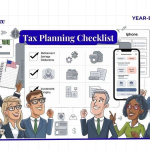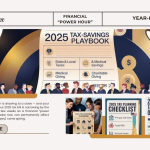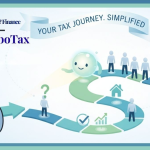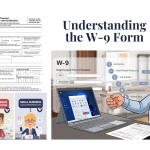Paycheck to Pay-In: Navigating the Estimated Taxes Maze
What Are Estimated Taxes?
Imagine you are self-employed, running a small business, or earning money from investments. Unlike people with regular jobs, you do not have taxes automatically taken out of your paycheck. Instead, you need to pay taxes on this income yourself throughout the year. These payments are called “estimated taxes.”
Read also Strategic Way – Tax Strategies of the Wealthy: Insights from a Top Tax Expert
For example, if you are a freelance graphic designer making $5,000 a month, you’ll need to set aside a portion of that income for taxes and pay it to the IRS four times a year.
Who Needs to Pay Estimated Taxes?

You might need to pay estimated taxes if you’re:
Check if you need to file a tax return on the official Site
- A freelancer or independent contractor (e.g., Uber drivers, website designers, consultants)
- A small business owner (e.g., shop owners, restaurant proprietors)
- Someone who earns a lot from investments (e.g., stock dividends, rental property income)
- Retired and receiving income that doesn’t have taxes withheld (e.g., some pension plans)
Generally, if you expect to owe $1,000 or more in taxes when you file your return, you should be paying estimated taxes.
Why Pay Estimated Taxes?
The government wants its money regularly, not just once a year. Paying estimated taxes helps you:
- Avoid a huge tax bill at the end of the year
- Steer clear of penalties for not paying enough tax throughout the year
Let’s say you owe $10,000 in taxes for the year. If you wait until April 15th to pay it all, you might face penalties. But if you pay $2,500 each quarter, you’re in the clear.
How Rich People Avoid Paying Tax: Discover 15 Tax Optimization Strategies
How to Calculate Your Estimated Taxes

- Guess how much money you’ll make this year
- Example: You expect to make $60,000 from your online business
- Subtract any tax deductions you think you’ll have
- Example: You estimate $10,000 in business expenses, leaving $50,000 in taxable income
- Figure out how much tax you’ll owe on that amount
- Use the current tax brackets to calculate this
- Don’t forget about self-employment tax if applicable
- Example: Let’s say your total tax comes to $12,000
- Divide that number by 4 (because you’ll pay four times a year)
- In this example, you’d pay $3,000 each quarter
This gives you a rough idea of how much to pay each quarter. Don’t worry if it’s not perfect – you can adjust it later if your income changes.
When to Pay Estimated Taxes

Mark these dates on your calendar:
- April 15th (for money earned from January 1 to March 31)
- June 15th (for money earned from April 1 to May 31)
- September 15th (for money earned from June 1 to August 31)
- January 15th of the next year (for money earned from September 1 to December 31)
If these dates fall on a weekend or holiday, you can pay on the next business day.
How to Pay Estimated Taxes (Click to Know More)
You have several options:
- Online through the IRS website (fastest and easiest)
- By phone, using the IRS payment system
- By mail using the estimated tax payment vouchers (Form 1040-ES)
For online payments, you can use your bank account (free) or a credit/debit card (for a fee).
Tips to Make Paying Estimated Taxes Easier
- Set up a separate savings account just for taxes
- Example: Transfer 25-30% of each payment you receive into this account
- Use budgeting apps or software to help track your income and estimate taxes
- Popular options include QuickBooks Self-Employed, FreshBooks, or even a simple spreadsheet
- Set reminders on your phone or calendar for payment due dates
- Set multiple reminders: 2 weeks before, 1 week before, and the day of
- Consider making smaller, monthly payments instead of quarterly
- This can make budgeting easier and ensure you always have enough set aside
Avoiding Penalties

To stay on the IRS’s good side:
- Pay at least 90% of what you end up owing for the current year, or
- Pay 100% of what you owed last year (110% if you’re a high earner)
If you do this, you shouldn’t face any penalties, even if you owe more.
Example: If you owed $10,000 in taxes last year, paying at least $2,500 each quarter this year (totaling $10,000) should protect you from penalties, even if you owe more when you file.
What If Your Income Changes?
Life happens, and income can go up or down. If your income changes a lot:
- Recalculate your estimated taxes
- Adjust your next payment to make up for any shortfall or overpayment
Example: You estimated $60,000 in income, but halfway through the year, you realize you’ll make $80,000. You can increase your remaining payments to cover the additional tax owed.
Also Read: Tax Evasion Laws: How to Avoid Jail by Mastering Evasion Laws
Special Situations
Seasonal Businesses
If your income isn’t evenly distributed throughout the year (e.g., a landscaping business is busier in summer), you can use the “annualized income installment method.” This allows you to pay different amounts each quarter based on when you earn the income.
First Year in Business
If this is your first year paying estimated taxes, don’t panic! Use your best guess for income and adjust as you go. The IRS understands that first-year estimates can be tricky.
Getting Help

If you’re feeling overwhelmed:
- Use the IRS’s free tax withholding estimator tool
- Consider using tax preparation software that includes estimated tax calculations
- Consult with a tax professional, especially if your situation is complex
Real-Life Scenario – A Year in the Life: Sarah’s Freelance Tax Journey
Let’s follow Sarah, a freelance web designer, through her year of estimated tax payments. This example will show you how the process works in real life.
Sarah’s Situation:
- Freelance web designer
- Expected annual income: $80,000
- Estimated business expenses: $15,000
- First-year as a full-time freelancer
Step 1: Initial Estimate (January)
Sarah sits down to estimate her taxes for the year:
- Expected income: $80,000
- Estimated expenses: $15,000
- Taxable income: $65,000 ($80,000 – $15,000)
Using a tax calculator, Sarah estimates she’ll owe:
- Federal income tax: $9,250
- Self-employment tax: $9,180
- Total estimated tax: $18,430
Divided by 4 quarters = $4,608 per quarter
Step 2: First Quarter Payment (April 15)
Sarah makes her first estimated tax payment of $4,608 through the IRS website.
Step 3: Income Increase (May)
Sarah lands a big client, increasing her projected annual income to $100,000. She recalculates:
- New expected income: $100,000
- Estimated expenses still $15,000
- New taxable income: $85,000
New tax estimate:
- Federal income tax: $13,750
- Self-employment tax: $12,000
- Total estimated tax: $25,750
Remaining over 3 quarters: $21,142 ($25,750 – $4,608 already paid) New quarterly payment: $7,047
Step 4: Second Quarter Payment (June 15)
Sarah pays $7,047 for her second-quarter estimated taxes.
Step 5: Third Quarter (September 15)
Sarah’s income is on track with her revised estimate. She makes another payment of $7,047.
Step 6: Fourth Quarter Planning (December)
Sarah reviews her year:
- Actual income: $98,000
- Actual expenses: $14,000
- Taxable income: $84,000
Final tax calculation:
- Federal income tax: $13,450
- Self-employment tax: $11,880
- Total tax: $25,330
Sarah has paid $18,702 so far ($4,608 + $7,047 + $7,047). She owes $6,628 for the final quarter.
Step 7: Final Payment (January 15)
Sarah makes her final estimated tax payment of $6,628.
Tax Time (April of next year)
When Sarah files her taxes, she finds she calculated almost perfectly. She only owes an additional $100, which she pays with her tax return. She avoided any penalties by making accurate estimated payments throughout the year.
Key Takeaways from Sarah’s Year:
- Start with your best estimate, but be prepared to adjust.
- Recalculate when your income changes significantly.
- Keep track of your actual income and expenses throughout the year.
- Don’t panic if your estimates are off – you can adjust in future quarters.
- Save your payment confirmations for your records.
By following Sarah’s example, you can see how estimated taxes work in practice. Remember, your situation may be different, but the principles remain the same: estimate, pay quarterly, adjust as needed, and keep good records.
Wrapping Up
Paying estimated taxes might seem tricky at first, but it gets easier with practice. By staying organized, setting aside money regularly, and keeping an eye on payment dates, you can avoid surprises and penalties. Remember, it’s okay to ask for help from a tax professional if you’re unsure about anything. Happy tax planning!
Thank you for reading this post, don't forget to subscribe!






